Small Business Credit Insights
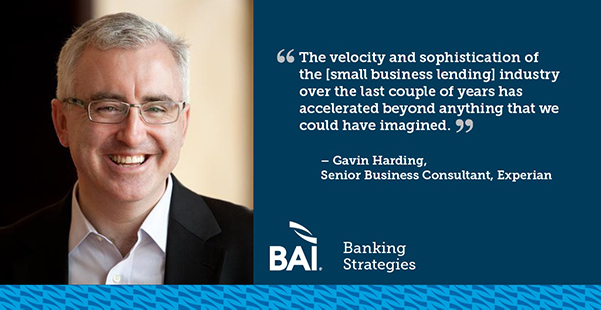
Click image to play the podcast This episode of the BIA Banking Strategies podcast was originally published on BAI Banking Strategies website. [Lou Carlozo]: For small businesses in 2018 the signs and indicators are complex. Bankruptcies are up, but credit conditions have finally shifted for the better. Some remain battle scarred and debt averse from the Great Recession. Yet, others see this as a time to aggressively pursue growth. How can banks make sense of these signs and take advantage of the times? To find out we'll talk with Gavin Harding Senior Business Consultant with Experian. [Lou Carlozo]: Welcome to BAI Banking Strategies where each week we'll focus on the key issues facing financial services leaders. We'll bring you objective opinions and actionable insights that will help you power smart decisions. I'm your host, Lou Carlozo, the managing editor of BAI, come on in. Don't miss our immersive annual event BAI Beacon which takes place in Orlando Florida October 9th through 11th. It takes a team to transform an organization and each team member has their own area of expertise that's critical to the effort. In the BAI Beacon, you can find the topics most relevant to your individual role and regroup at the end of the day with fresh perspective and ideas. Save 50 percent when you register before May 31. To find out more visit www.bai.org/baibeacon. [Lou Carlozo]: Thanks again for tuning into the podcast. It is great to have you here with us. And today on the program we have Gavin Harding the Senior Business Consultant with Experian Decision Analytics Global Consulting Practice. For more than half of his career Gavin held senior leadership positions with a large regional bank gaining experience in commercial and small business strategy, SBA lending, credit and risk management and sales. Gavin great to have you on the podcast today. [Gavin Harding]: Good to be here Lou. Thank you for inviting me. [Lou Carlozo]: Experian in conjunction with Moody's Analytics has this new report out the Main Street Report. Your window into small business health. So are small businesses healthy right now? [Gavin Harding]: Small businesses are very healthy right now. When you think of a small business's performance you think of it two ways one is in terms of you know revenue and overall health, and the other is in terms of access to credit how they pay their bills? For our purposes today we're thinking more about it from a lending banking perspective. From that perspective, bankruptcies are low and have been low for several quarters. Delinquencies are low and have been low for several quarters. So the fundamentals of small business are very robust very strong. [Lou Carlozo]: Small businesses are enjoying a great time. That doesn't mean of course that they're not without challenges and I'm going to read a portion of the report. Bankruptcies continued to rise in the fourth quarter making 2017 a full year in which bankruptcies increased every quarter. Taken alone this isn't good news but bankruptcies are coming off historical lows. Give us a little bit more insight as to what is going on here? [Gavin Harding]: Sure, so let's go back in time a little bit to the dreaded year 2008 when the world pretty much ended in financial terms. Massive turmoil. We tightened up credit. The whole industry worked through a series of losses. After a couple of years those portfolios were pretty well cleared out. So what was left was decent solid businesses with good fundamentals and a lot of the weak players had been essentially weeded out of the market. So time goes on, small businesses slowly start to invest but they were very leery of taking on a lot of debt but they had made it through the war. So those businesses had good credit performance. They were paying their bills and that went on for several years, and for I think it was 14 quarters. We saw that those small businesses continued to pay on time, continued to be good stewards. And then we get to 2017. [Lou Carlozo]: And then what? [Gavin Harding]: So in 2017 there was a lot of change. There had been limited investment from small business for a long time, and there is only so long that you can wait to invest. There comes a point when equipment breaks, when you need to hire people. Businesses became more optimistic. Lenders, bankers, fintech's started to open up the credit box a little bit broader standard. For 14 quarters we saw that those small businesses continued to pay on time, continued to be good stewards in terms of their investment. Good performance, very low bankruptcy levels, and then they really start to get a little optimistic a little confident, money starts to flow. We would expect that delinquencies would increase a little bit over time. We would expect that low bankruptcy rate to increase. So my perspective on that is that while it is something we should keep an eye on. It's very much an indication of growth, of confidence, of enthusiasm and investment. [Lou Carlozo]: What do you see as the most important context heading forward? [Gavin Harding]: The single most common question we have been asked over the last 18 to 24 months is when is it going to turn? And of course if we knew when it was going to turn I would be a retired multibillionaire. So the best we can do is look for indications right? and when we look for indications we look for those on a macro level, unemployment, and as we approach and reach full employment what does it do to wage growth? What does it do to access the human capital? And then we also look at it on a more micro level which is you know within our portfolio what are we seeing that's going to give us that hint? So if we start seeing instead of a gentle upward trend that we might think about in terms of a return to normality, if we start seeing for instance in our credit card portfolios for small businesses, those delinquencies spike, if we start to see those cards maxed out and delinquencies increase, that could be one of those very early signs. The other thing just keep in mind is this, the industry and when I say the industry I'm thinking about finance, over the last couple of years, has transformed in many ways. We all need to have a digital presence. We need to engage customers when they want to communicate with us. And when we need to do that with the products that they're looking for, and at the same time as we deliver this in a very slick quick way we have to maintain good solid robust risk management. And at the same time as we do all of that, we've got to make sure the fraudsters are held at bay and we minimize identity fraud and other types of fraud. So the whole industry has accelerated, it's very much now about digital technology. Customers are looking for quick and ready access. That opens all kinds of other risks for us. We're talking about integrated fraud risk. We are talking about you know advanced analytics on the portfolio. We are talking about operational risk, and our favorite kind of risk, regulatory risk, as we work to comply with regulations that are new and still evolving and haven't been tested yet. So it really is the velocity and sophistication of the industry over the last couple of years has just accelerated beyond anything I think we could have imagined. [Lou Carlozo]: I think the other consequence of this is clients sometimes getting jittery, getting nervous and one of the things that you specialize in is getting into those situations when things don't go as smoothly as a client might like, and offering some remediation, some help keeping things calm and moving forward. Tell us a little bit about how you do that work because you do it so well. [Gavin Harding]: We have clients that have either been in business a long time, or are relatively new to the space and there's often a common feature in the feature is, that they have grown many times grown rapidly, and what they had in place at the beginning was augmented and there was lots of other stuff bolted on. Prime example, banking client, regional bank, 67 separate systems and applications, none of which spoke to each other are connected. So you've got that rapid growth. You hit a certain kind of critical mass and you have to make the decision and the decision is are you going to stop assess, and identify a better way of doing things, and address all of these legacy systems and reports and legacy data and routines and processes? So in many cases working with clients we're able to stand back because we're outside right. We're outside, we know the industry, we've worked with a lot of clients but because we aren't involved in those processes day to day, we can look at them with a cold eye. We can assess them objectively against some of what we've seen other successful clients do. And in many cases, take heavily manual paper based processes and reports and decision making, and make it a lot more efficient, and by efficient, I don't mean you know automatic approvals I don't mean artificial intelligence. I mean old fashioned efficiency. So instead of doing something in ten steps can you do it in three. And when you take that analysis and you spread it across commercial lending for example, or through small business lending, there are some real opportunities to transform the process, to transform the experience of the people that have to work within the process, and ultimately to improve turnaround and accuracy the customer experience itself. [Lou Carlozo]: Turnaround accuracy. I would say this the banks and financial institutions are very fortunate to have you on their side. Gavin I want to thank you for making the time to be on the podcast today it was a real privilege. [Gavin Harding]: My pleasure. Thank you. [Lou Carlozo]: Gavin Harding is a Senior Business Consultant with Experian Decisions Analytics Global Consulting Practice. You can look for Gavin on LinkedIn. And here are three key takeaways from today's podcast: Bankruptcies are up for small businesses. In fact for four consecutive quarters in 2017 according to the Experian report. But that deserves a long view, post-recession. The small businesses that survived became very debt averse while banks tightened up lending. For small and medium sized businesses 2017 also marked a turning point to address needs such as replacing worn out equipment, or hiring badly needed staff. Some businesses haven't made it but it's nothing like the recession and it's a wave of doom. For small businesses in 2018 the news remains very positive, fundamentals are strong. Full employment is here, but there will always be potential storm clouds to keep an eye on. One is credit card delinquency spikes, another, moving too fast to address risks such as fraud. Businesses that have experienced rapid growth often suffer from bolted on systems and unconnected applications. In this case rapid growth means slowing it down. It comes down to four steps, stop, assess, identify and address. The endgame, find and implement efficiencies. [Lou Carlozo]: And now BAI Banking Strategies brings you the aha moment where our podcast guest shines a light on that point in time where realization revelation or exploration made all the difference in their financial services career. Now sometimes before you climb a mountain you've got to dig a hole and here Gavin Harding recalls how a visit from a federal regulator taught him a humbling lesson that he carries with him to this day. Listen. [Gavin Harding]: So let me take you back to Philadelphia in 1999. Being young and educated I was absolutely sure for a certainty that I knew pretty much everything I needed to know. And into that office walked a Federal Reserve auditor. He asked me a series of questions which I immediately answered, and over the course of an hour I dug a hole maybe 20 feet wide by 30 feet deep. Nice straight sides and I climbed on down into it. It took seven weeks and hundreds of files to undo the damage I did with reacting, with feeling, feeling that there had to be an answer that would be an answer now. With feeling that, as an executive, I had to have the answers. So my lesson from that experience and I keep it with me every day and it is part of every interaction with clients. First pause, and then clarify. So make room to think, understand that I didn't have to give an answer. Understand that "I'll get back to you" was a much better answer than a whole series of statements that may or may not have been connected, and were not thought out and were not researched. So I am greatly appreciative to the Federal Reserve for training me in 1999 in Philadelphia. This episode of the BIA Banking Strategies podcast was originally published on BAI Banking Strategies.

Pew Research Center has stated that the Millennials are projected to be the largest generation by 2050. So with this in mind Experian examined the business credit trends of Millennial business owners to see how their behaviors might impact small business. The results of that research has been published in a new whitepaper titled "Millennial-owned small business — a fast growing segment." Andrea Schmalzer is the analyst who worked on the study and we asked her a few questions about the research in our latest Business Q&A. Gary Stockton: Can you tell us a little about the data set you analyzed for your study? Andrea Schmalzer: In this study what we did was we looked at small businesses during the year 2012 2015 and 2017. We then segmented the data by generation for millennials. We looked at anybody born between 1981 and the year 2000. Andrea Schmalzer: There are various ranges for defining millennials. However this is definitely within the standard range of the definition. Gary Stockton: In terms of small business. How large is the millennial segment today? Andrea Schmalzer: So the millennial segment is actually still a smaller segment of the business community at about 7 percent. But they are growing quite rapidly. Since 2012 they've grown about 92 percent in small businesses. Whereas if you look at the baby boomers they've only grown by 11 percent. So there's definitely substantial growth happening within the millennial-owned business area. Gary Stockton: What are the industries that millennials are most concentrated in? Andrea Schmalzer: So the millennials are concentrated in basically the same industries as all other generations.We do see about 44 percent of all small businesses owned by millennials in the services industries. So that can be anything from a nail salon to a medical doctor. We then have about 18 percent in retail trade. So that's any goods that you're going to be buying for personal use, and then about 12 percent are focused in on construction industries. Gary Stockton: Do millennials represent an opportunity for lenders? and if so, how? Andrea Schmalzer: Absolutely. What we're seeing is a really strong decreasing trend in delinquency rate for millennials? So back in 2012 we were seeing about 18 percent delinquency rates. Currently in 2017, what we're seeing is about 9 percent which is totally in line with all other generations? We're also noticing their business credit scores improving year over year. As well as their longevity. So by year 5 their business survival rate is stronger than any other generation. At this point it looks like the millennials are starting to figure out the way that businesses work, and how to use credit wisely. So there's definitely room for lenders to appeal to this segment. Download Report
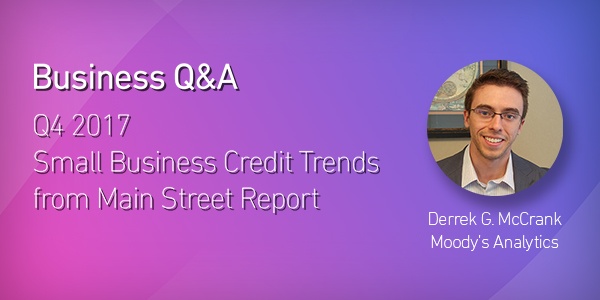
Gary Stockton: Experian has just released the Q4 2017 Main Street Report. We partner with Moody's Analytics on this report each quarter, and Derrek Grunfelder-McCrank is the economist who works on the report. We asked him a few questions about the trends that we're seeing in this quarter's data. Gary Stockton: The latest Main Street Report states that small business credit conditions remain positive. Is there a primary factor that's driving this stability? Derrek G. McCrank: Yeah there certainly is Gary. The primary factor that's driving stability in small business credit is the broader U.S. economy. Right now we have the labor market that's tight. This is resulting in wage increases for consumers as a result. Consumer spending has been reliable. Inflation is starting to pick up in a slow steady manner. On top of it all at the end of last year we just got tax reform. Right now the outlook for small business credit is positive. And that doesn't look set to change anytime soon. Gary Stockton: and are you seeing greater numbers of small businesses investing in that business by borrowing for equipment purchases? Derrek G. McCrank: Well Gary while we can't say for certain. The data seems to suggest that this isn't happening to the extent it could just yet. One of the questions in the NFIB's monthly survey is about whether firms are planning capital expenditures in the next three to six months. Since the end of the last recession. We've seen the positive response rate to this question steadily increasing. However it still sits below its long term average. Couple this with tax reform coming so late at the end of last year, and a decent number of firms are likely to have waited until the new year when they could invest in their business with a little more certainty. Gary Stockton: Well historically small businesses been keeping bankruptcy in check, but this quarter we saw it up slightly. Is this a major concern? Derrek G. McCrank: This isn't a cause for concern yet. Though it is something to monitor going forward. In the first quarter of 2017 the small business bankruptcy rate bottomed out, it hi its floor. As the year progressed, the bankruptcy rate moved off of that floor and that appears to be all that happened. In fact I'm hopeful that this might indicate a return to a more dynamic environment for small businesses which I look forward to discussing in a little more detail and our upcoming webinar. But for now, given the state of the economy, I'm optimistic for the state of small business credit. Gary Stockton: On the flip side, the Northeast saw a steep decline in business bankruptcies in Q4. Can you share some insight on what might be driving that? Derrek G. McCrank: Sure, so in the fourth quarter. the Northeast saw declines in its severely delinquent or 90 days past due rate coupled with a slight uptick in its business bankruptcy rate. What happened with business bankruptcies mirrored the trend nationally, so it shouldn't be a cause for concern this year, the declines in the severely delinquent rate were driven by two primary factors - geography and industry, from a geographic point of view, Connecticut, New Hampshire and Maine were the driving forces behind the reductions in severe delinquency, and from an industrial point of view financial services, public administration and the manufacturing industries are credited with declines in severe delinquency. Download the latest report

According to the Kauffman Foundation business starts in the United States have been on a steady decline for the past four decades, while the cost of education has risen. In fact, as of 2017, outstanding college debt stood at 1.4 trillion dollars. So how does student debt impact business owners who started a business after college? In our latest Business Q&A I ask Andrea Schmalzer about her recent study of business owner student debt. Gary: Andrea why did you to decide to study student debt for small business owners? Andrea: Hi Gary we decided to take a look at student loan debt in regard to small businesses due to the fact that student loan debt has now increased to over one point four trillion dollars. In addition to that, small business creation has been on a downward trend basically since the 1990's. So we decided to take a look and see if student loan debt was impacting new business creation and longevity. Gary: And are there any industries where student debt has seen a significant increase? Andrea: Yes. In the public administration segment, which includes prisons, research laboratories, realtors, state run businesses, we saw an increase of student debt of about 89 percent between the years 2012 and 2017. So right now small business owners are opening their businesses with close to 60 thousand dollars in debt, when back in 2012 it was just over 30 thousand. Gary: And were there any other interesting insights that you saw in the data? Andrea: Actually yes. The biggest finding that we had was that having student loan debt didn't impact business survival. We have in our sample almost 79 percent of small businesses with student loan debt lasting five or more years. And that's compared to about 60 percent survival rate of five or more years for small businesses as a whole. So we're seeing a definite positive trend with small business owners acquiring student debt. To learn more about these insights, download the whitepaper. Download Whitepaper Help us spread the word! Click To Tweet!
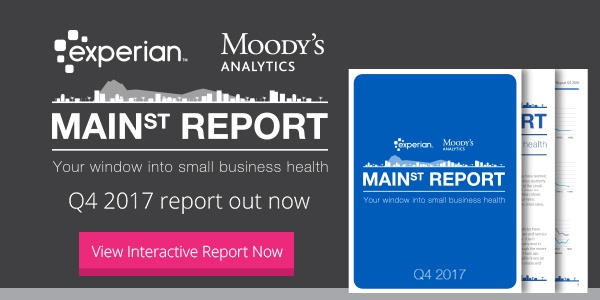
Experian and Moody’s Analytics just released the latest Experian/Moody’s Analytics Main Street Report for Q4 2017. The report brings deep insight into the overall financial well-being of the small-business landscape, as well as providing commentary around what certain trends mean for credit grantors and the small-business community. The overall outlook for small-business credit is positive. Outstanding balances rose in the fourth quarter, as did the average balance outstanding per business. Delinquency and default rates rose slightly, suggesting that credit conditions have loosened. Continuing strength in the macroeconomy will keep small businesses moving in the near term, along with higher profits from the recently passed tax legislation. Small-business credit will be less certain in the medium to long term as rising wages and tax code changes take a toll. Northeast sees the steepest decline in delinquency The Northeast saw the steepest decline in severe delinquencies in the fourth quarter, and construction was one of the industries responsible for that trend. Many small construction firms have a focus on residential projects, making consumer credit growth an ideal metric to use as a basis for understanding what’s happening and what will happen in the industry. We have published the entire contents of the report in an interactive page, complete with charts and graphs. Download Main Street Report

Andrea Schmalzer is an analytical consultant in the Commercial Data Sciences team here at Experian, and she just completed a study of the mining industry titled "Managing volatility: the unique credit risks of the mining industry", so we did a quick Q&A with Andrea about her research. Gary: Hi Andrea, why did Experian study the mining industry? Have there been any notable changes to this industry in recent years? Andrea: Hi Gary. We decided to study the mining industry in order to evaluate the impact the mining industry has on small businesses that are supporting that industry. Knowing that there will be some volatility as we see shifts in which fossil fuels are predominantly being used. As far as changes go, we have seen a decrease in coal production. Some of this is due to the fact that we had the big boom in natural gas which caused the natural gas prices to decrease substantially. And also just due to the fact that the coal supplies are decreasing overall. Gary: Can you tell us what states driving the bulk of the mining in the United States. Andrea Schmalzer: So Texas is the number one oil and gas producers in the country. As far as natural gas we also had that being mainly produced in Pennsylvania and Oklahoma. For oil, we do see that being produced in North Dakota and California, and as far as coal mining goes that comes from Wyoming, Kentucky and West Virginia. Gary: Andrea what impact has the decrease in natural gas and oil production had on the local small business economy? Andrea: So, North Dakota was one of the most impacted states when the prices of oil dropped because they decided to stop drilling because it wasn't cost effective. So we did see employment drop quite a bit in the oil and gas industry. But overall as a state North Dakota is still under a 3 percent unemployment rate. Some of those folks are now working in retail or grocery stores, gas stations in hopes that new drilling will come up again. For businesses though we do see delinquencies shrinking in the retail segment also in the manufacturing segment. However we do see charge off's increasing for both retail and manufacturing which is one area we need to keep an eye on. Gary: With the falling supply of coal in West Virginia what trends are you seeing in business credit and delinquency? Andrea: Like you said we've seen a large decrease in coal production in West Virginia, most notably in the southern counties of West Virginia. And with that we've seen an increase in unemployment and in some cases an increase in delinquencies. For example the retail and service industries have seen an uptick in delinquencies in southern West Virginia compared to the rest of the state. But we aren't seeing write off's come through yet. So an area to keep an eye on. Also overall in West Virginia we do see higher delinquency rates in the agricultural industry for the coal counties versus non-coal counties. But again, like retail and service we aren't seeing the write the off's come through yet. So definitely an area we need to keep an eye on. Download Whitepaper
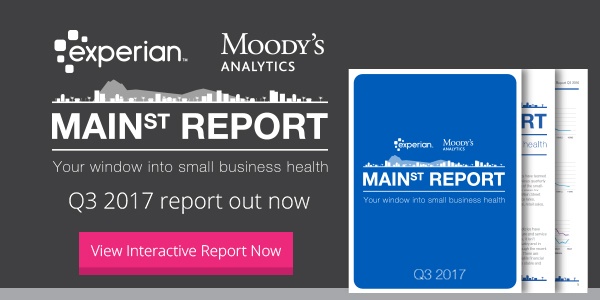
Experian has just released the Q3 2017 Experian/Moody's Analytics Main Street report and the overall outlook for small-business credit is stable. The report states outstanding balances on small-business credit declined slightly in the third quarter, continuing a two-year trend. Delinquency and default rates were steady to declining, and business balance sheets continue to improve. Continued improvement in the labor market and economic growth bodes well for credit performance in the short term. Despite the overall optimism, pockets of localized weakness are developing and will warrant observation over the next few quarters. “Small business credit conditions are good and steadily getting better. Businesses are paying on their obligations in an increasingly timely way and remain cautious in their new borrowing. There are some credit problems in different parts of the country in various industries, but they are few and far between.” Mark Zandi, Chief Economist, Moody's Analytics An expanding economy supports credit performance As small businesses continued to keep credit utilization low, paying down debt, delinquencies overall continued to trend downward. Early-stage delinquency rates improved during the quarter while the 90 days past due (DPD) delinquency rate experienced a slight 5 basis point increase. The most severe delinquency category, 91+ days past due, declined as some distressed credit was charged-off. The decline in late-stage delinquency was offset somewhat by an increase in bankruptcy rates. While the report contained mostly good news, there were a few surprises, including Wyoming, which saw a slight increase in 90-days past due delinquency in mining, construction, transportation and retail, pushing the state’s delinquency rate by almost half a percentage point. We have put the entire contents of the Experian/Moody’s Analytics Main Street Report into an interactive page, complete with dynamic charts.

Within the span of two weeks, two states in the Southeast - Texas and Florida, have been devastated by two category 5 hurricanes. It has been over a decade since the United States last fell victim to another category 5 hurricane, Katrina, which submerged New Orleans under 20 feet of water and displaced 1.3 million people to find shelter anywhere and everywhere across the U.S. However, within one year, New Orleans would see 66% of its pre-Katrina population return, and sales tax revenue climb to 84% of pre-Katrina levels.The road to recovery will no doubt be arduous, but there is also no doubt that the resilient people of these states are already marching steadfastly on that road. The recovery effort is supported by FEMA, the U.S. Federal Emergency Management Agency, which has already approved $124 million to support individuals and households in Florida and $408 million to support those residents impacted in Texas. Along with direct support for its people, the U.S. government is accepting and approving SBA loans for businesses impacted by Hurricane Irma and Harvey. As residential rebuilding plans begin, many of the people living in these regions are also employees and business owners whose places of work may also need weeks or months to rebuild, if they rebuilt at all. How quickly the area’s economy recovers has obvious implications for the people and businesses in the region, but it also has far-reaching implications for businesses that depend on the region as a source of revenue as well. Experian is looking to its wealth of business credit data to gauge the overall magnitude of the disaster and the impact to regional businesses. Nearly 1.5 million businesses in Texas are in FEMA declared Hurricane Harvey impacted counties. This represents one in three businesses in all of Texas. The businesses impacted have $10 billion in outstanding payables and represents 31% of all commercial payable balances in Texas. The businesses in the impacted regions, on average, have very similar credit profiles to the rest of the businesses in Texas, with the typical business being 10 years old, paying 7 days late, and having an Intelliscore Plus commercial credit score of 41 out of 100. In Florida, nearly all of the state has been enveloped by Hurricane Irma. 3.9 million businesses reside in Irma impacted counties, accounting for nine out of ten businesses in Florida. These impacted businesses represent 91% of total outstanding commercial payables in Florida, summing to over $26.6 billion. That is over two and a half times higher the balance potentially at risk in Texas. As of August 2017, $3 billion of the payables are delinquent, and as most businesses focus on recovery, these delinquent dollars may slide into further delinquency. Businesses in Florida are, on average, slightly over 10 years old, pay 8 days late, and have an Intelliscore Plus score of 41. From an industry sector point of view, professional and business services were hardest hit in both states, with these businesses accounting for over 40% of all businesses impacted for each state, respectively. In Texas, professional and business services owe $2 billion in payables. In Florida, businesses in this sector carried over three times that balance, owing $6.5 billion in payables, with over $700 million already delinquent. In Texas, other industry sectors significantly affected include construction and retail trade, each accounting for 16% of businesses in the impacted region, and having $7.6 billion and $9.6 billion in total payables, respectively. In Florida, retail trade businesses represent 18% of all businesses affected, and account for $2.9 billion in commercial trade balance owed. Businesses in finance, insurance, and real estate account for 12% of businesses in the impact zones, and owe $1.7 billion in outstanding balance. Construction businesses in Florida represent nearly 10% of businesses affected. As Florida has a smaller percentage of businesses in the construction industry overall compared to Texas (10.1% vs 14.5% respectively), and 90% of construction businesses in Florida are in designated impact counties, Florida may require more assistance from outside the state to support their rebuilding effort. Smaller and younger businesses in general face lower odds of continued prosperity, and these businesses are the most susceptible to the devastation of Hurricane Harvey and Hurricane Irma. The impacted areas for both states are dominated by smaller businesses, with nearly 90% of businesses having four or less employees, and almost 100% having less than 50 employees. Even though they are small, these businesses account for $8.7 billion, or 86% of payables impacted, in Texas. In Florida, these small businesses total $23.8 billion in payable balance, which constitutes 90% of all impacted payables. Many of these small businesses are young, but Florida businesses are more mature than businesses in Texas. In Florida, 3.5 businesses out of 10 have been credit active for less than six years, compared to 4 out of 10 businesses in Texas. These young businesses in Texas owe a total of $2.7 billion, while young businesses in Florida owe two and a half times that amount, at $6.9 billion. Over the next several months, Experian will measure the financial impact of businesses caught in the devastating path of Hurricanes Harvey and Irma. We will track changes in key metrics that can provide insight into the level of progression of recovery by location and type of business. Businesses integral to the recovery efforts, such as home improvement suppliers, construction companies, sanitary service companies, and the workers they employ, will undoubtedly prosper as their products and services are immediately in demand and in short supply.Younger businesses and businesses in more severely impacted regions will have a difficult road ahead. We will continue to track credit activity, such as changes in spend, utilization, new trade openings, and payment delinquency trends, to identify business sectors and profiles that appear to be rebounding, and those in further need of assistance. Subscribe to our blog for the latest updates on the business recovery progress from Hurricanes Harvey and Irma.
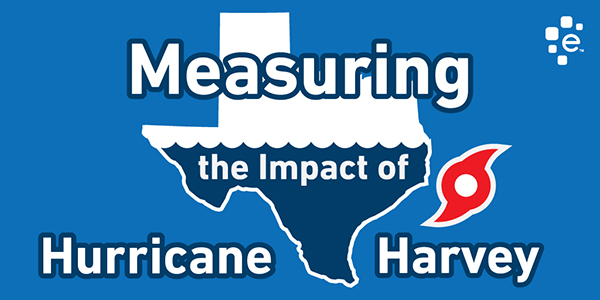
As the recovery gets underway, it will take months to assess the full economic impact of the unprecedented devastation brought to South Texas by Hurricane Harvey. Thousands of residents have been displaced, and as food and shelter are delivered and residential rebuilding plans begin, many of these people are also employees and business owners whose places of work may also need weeks or months to rebuild, if they will be rebuilt at all. How quickly the area’s economy recovers has obvious implications for the people and businesses in the region, but it also has farther-reaching implications for businesses that depend on the region as a source of revenue as well. Experian looked to its wealth of business credit data to gauge the overall magnitude of the disaster and the impact to regional businesses. Nearly 1.5 million businesses in Texas are in FEMA declared Hurricane Harvey impacted counties. This represents one of three businesses in all of Texas. The businesses impacted have $10 billion in outstanding payables and represent 31% of all commercial payable balances in Texas. The businesses in the impacted regions, on average, have very similar credit profiles to the rest of the businesses in Texas, with the typical business being 10 years old, paying 7 days late, and having an Intelliscore Plus commercial credit score of 41 out of 100. Statistics for areas impacted Texas Impacted Impact % TX Number of businesses 4,823,364 1,411,583 29.27% Total balances $ 32,334,156,000 $ 10,014,029,400 30.97% Bal 1-30 $ 1,630,010,705 $ 515,641,208 31.63% Average utilization 26.22 27.34 Average IPV2 Score 40.93 40.54 From an industry sector point of view, professional and business services were hardest hit, with these businesses accounting for over 40% of all businesses impacted. Professional and business services owe $2 billion in payables. Other industry sectors significantly affected include construction and retail trade, each accounting for 16% of businesses in the impacted region, and having $7.6 billion and $9.6 billion in total payables, respectively. Impacted Businesses by Industry Smaller and younger businesses in general face lower odds of continued prosperity, and these businesses are the most susceptible to the devastation of Hurricane Harvey. The impacted areas are dominated by smaller businesses, with nearly 90% of businesses having four or less employees, and almost 100% having less than 50 employees. Even though they are small, these businesses account for $8.7 billion, or 86% of payables impacted. Many of these small businesses are young, and there are two in five businesses in the impacted counties that have been credit active for less than six years. These young businesses owe a total of $2.7 billion, or 27% of outstanding payables. Impacted Businesses by Company Age Over the next several months, Experian will show the level of progression of recovery by location and type of business. To be informed when we post about this topic, subscribe to our blog.
